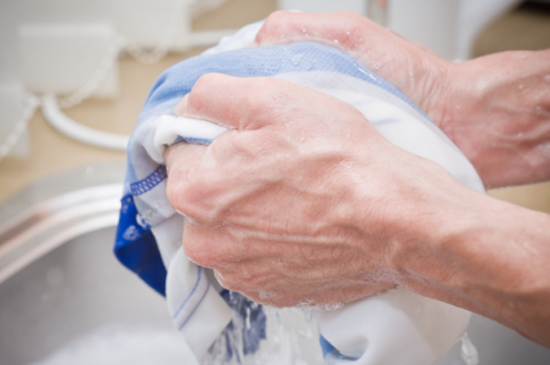
Hand washing clothes is quickly becoming a lost art in today’s world. As wash and wear garments and more casual looks and fabrics have become more popular, more people than ever have wardrobes that are made up entirely of items that can be thrown in the washer and dryer. The big drawback with these types of clothing is that it limits you in the styles you wear and especially when it comes to delicate garments, fine fabrics and adorned outfits. Many such items need dry cleaning or hand washing in order to preserve their quality. With the high cost and inconvenience of dry cleaning proving to be stumbling blocks for many people, hand washing is the only remaining option. Knowing how to properly hand wash clothes will save you money and open up a whole new world of rich fabrics and clothing options that you’ve only dreamed of.
The true way to hand wash clothes is to start by spot treating any stains on the clothes, like you would if you were washing by machine. Fill up the sink, or a container big enough to hold your item and allow for agitation, with cold water. The cold water will prevent shrinking and color fading. Add laundry soap that is specifically formulated for hand washing in cold water. Be precise with the measurement as it will take a long time to rinse out excess suds if you add too much. When the soap is completely dissolved, add the item of clothing you wish to wash. If you have more than one item that needs hand washing, do only one at a time.
Move the clothing around in your soapy water gently in order to create mild agitation. This will allow the water to work through the garment loosening dirt. Pay particular attention to the underarm area, the neckline and any spots on it. Gently rub such areas with your fingers to remove stubborn stains and odors. When you are content that your clothing item is as clean as possible, you will need to rinse it. Using cold water only, rinse the item multiple times until no bubbles are produced when you add water.
With all the suds out of your hand washed item, it is time to dry it. Gently squeeze as much water out of the item as possible. Compress the fabric gently and do not twist it. Then using a heavy absorbent dry towel, lay the clothing flat and roll it up in the towel. Repeat gently compressing the rolled towel to get out excess moisture. Check the item’s label for further drying instructions. You may be able to put it in a cool dryer, hang it to dry or lay it flat to dry. Whatever the drying technique used, you will have sped it up considerably by getting the item as dry as possible before hand.
The alternative to true hand washing is to use your washer’s extra gentle cycle. It may even have a setting on it called hand wash. Be sure to use cold water and special detergent. This is a much more time efficient way to “hand wash” your items that need such treatment. However, one thing to keep in mind is that while the setting is very slow and gentle it is still a machine and the possibility for damage to your clothes still exists.
Learn to properly hand wash clothes now and enjoy the world of delicate clothes while saving money too.




